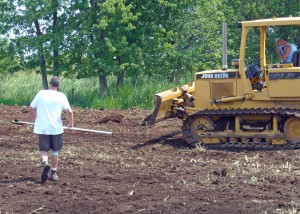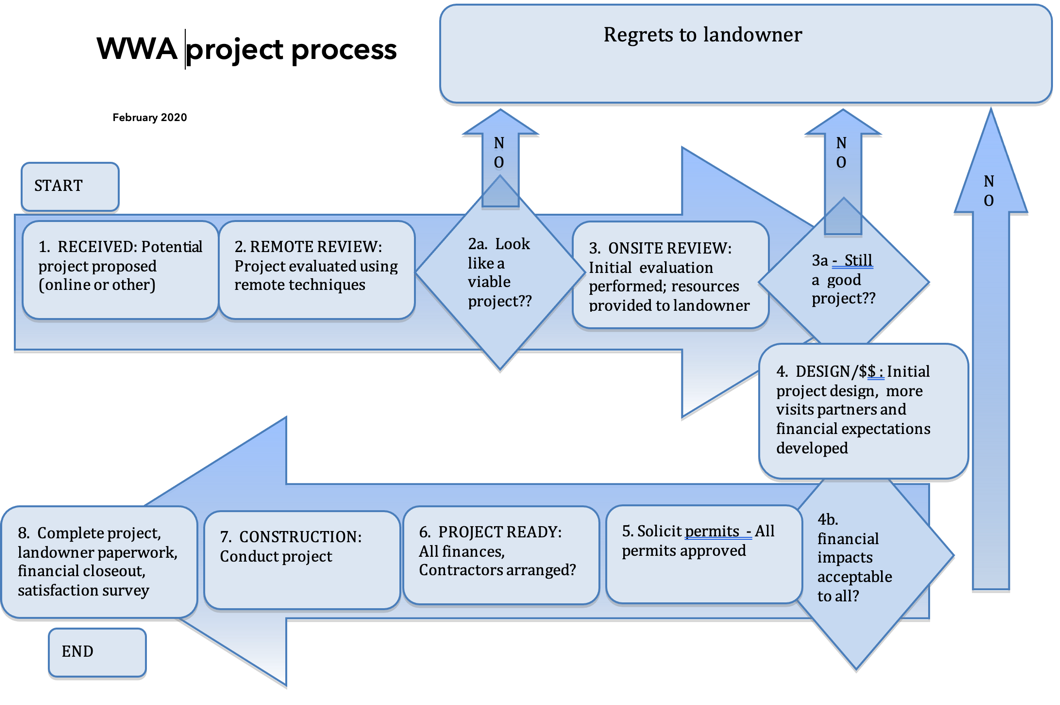 By Bruce Ross, Executive Director bruceross@wi.rr.com
By Bruce Ross, Executive Director bruceross@wi.rr.com
This article originally appeared in Wisconsin Waterfowl Association’s May, 2021 Newsletter edition.
This is the second of a series of articles designed and written by a layman to help guide landowners who may want to restore their property’s wetlands to be more productive for wildlife. This series is not about doing a restoration itself, but focuses on helping the interested landowner think about their potential restoration and find the right help as quickly as possible.
Interestingly, an Army Corps of Engineers leader in this region read the Part 1 article, and offered to collaborate with WWA’s habitat ecologist on an article we’ll roll out next month that reveals a little about design considerations that tend to be successful in the all-important design and permitting parts of this process.
- Part 1 – Lessons learned for the neophyte wetland restorer
- Part 2 – Shortening the learning curve and establishing realistic goals
- Part 3 – What to expect during your restoration
This Part 2 article will focus a few words on how to quickly identify options and establish goals that will help guide your efforts through the process.
 Start broadly with a free review of your property. Then, narrow your engagement to the organizations that can help you most. There are two state-wide organizations that specialize in helping private landowners understand their wtland restoration opportunities: WWA (us) and United States Fish & Wildlife Service (USFWS).
Start broadly with a free review of your property. Then, narrow your engagement to the organizations that can help you most. There are two state-wide organizations that specialize in helping private landowners understand their wtland restoration opportunities: WWA (us) and United States Fish & Wildlife Service (USFWS).
- Both of these organizations are willing to send wetland ecologists to evaluate your property. Beyond that, it depends on what conditions they find.
- At a minimum, they will provide their best insights into the possibilities they see on your property, and if permits are required, they can help develop the applications with you. This alone is a huge deal!
- But if your goals and their missions align, there may be some financial assistance to bring your project into existence.
- And even if they can’t help financially because your land opportunities don’t align with their organization’s expectations, they know the organizations that do align with them. And can provide direct connections to them.
- These might include: Natural Resources Conservation Service (NRCS) – including Farm Bill biologists, county land/water departments, regional conservation efforts, and many others. There’s a whole constellation of conservationists who may be able to checks the survey gear on a project site in August 2016 help you, and these WWA and USFWS biologists can point you towards the right persons.
- Establish goals for your project. Before your initial meeting with an ecologist, have a list of things you think you’d like to do. Revisit that list after your initial meeting and refine them based on that discussion. These can be as simple as “retain more water on my land,” or “reduce the cattails that have invaded my scrapes,” to the more complicated, like “provide improved breeding habitat for waterfowl,” or “improve the holding power of my land during migration.”
- Having specific goals allows you to organize the steps needed to achieve them, and helps keep you on track when costs and options can get overwhelming.
- Based on your initial consultation, revise your goals, and with who, and how, they can be achieved. Based on your discussions, what steps are needed to get to your goals: plug a ditch, disable drain tile, move earth… This allows you to consider how to phase aspects of the project, and maybe spread costs over time while you work towards those goals.
- And be sure to tease out who might be the best organization to help you with them.
- Treat your wetland restoration as a true project. in a former life, I was a project manager. As every project manager knows, for every project, there are different balance points between time, money and performance (here, “performance” means maybe the size of your project, or the scope of changes you will see on your land, etc.). Changing one factor has an impact on the other two factors.
- Money solves all, right?! If you are willing to invest more money, you can do things on a shorter timeline, or increase the “performance” of your wetland. But if you’re looking for help with that financial piece, you need to be willing to accept impacts on time and performance.
- And maybe, one phase of your project fits best with one or another organization, while the next phase fits best with a different one. An example:
- Phase 1: Keep more water on my land – by plugging ditches/disrupting tiles (WWA help + own investment).
- Phase 2: Establish water level control – by a water control structure and berming – (USFWS help + own investment).
- Phase 3: Reduce invasive cattails – by spraying, physical disruption, and water manipulation (private contractor– or self-help).
- Phase 4: Establish Wild Rice – by hand spreading rice seeds – (WWA procures rice, self-help seeding).
- Phase 5 – ongoing: Manipulate water levels for rice success (self help).
- There’s a process that most projects follow. Understanding the order in which the various steps happen is helpful. Here’s the process WWA follows, but it’s generic to virtually all restoration projects.
In Part 1, I wrote about the lessons I drew from my own experiences to help my fellow “wetland restoration journey-takers” better know what they don’t know (yet). My disclaimer has been and continues to be: I am not an expert, I’m simply sharing my experiences.
But there are experts, and WWA has one of them (although he’d probably be reluctant to use that term): Peter Ziegler. Peter has been restoring hydrology to small-ish parcels of land for nearly two decades. I sometimes think there is an art as much as there is a science to wetland restorations. I believe Peter blends the two sides of this coin to yield some of the very best wetland work that’s being done in this state. Contact him by inputting your property information in WWA’s form at our website.

